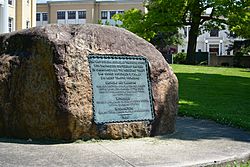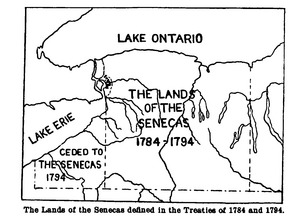Treaty of Canandaigua facts for kids
 |
|
| Signed | November 11, 1794 |
|---|---|
| Location | Canandaigua, New York |
| Signatories |
|
| Parties |
|
The Treaty of Canandaigua is an important agreement signed after the American Revolutionary War. It was made between the Grand Council of the Six Nations (also known as the Haudenosaunee Confederacy) and the United States of America, represented by President George Washington.
This treaty was signed in Canandaigua, New York on November 11, 1794. Fifty leaders, called sachems and war chiefs, signed for the Six Nations. These nations included the Cayuga, Mohawk, Oneida, Onondaga, Seneca, and Tuscarora tribes. Timothy Pickering, an official agent for President Washington, signed for the United States.
Contents
Why the Treaty Was Needed
The Treaty of Canandaigua came about because of several disagreements. After losing the American Revolutionary War, Great Britain had to give up land east of the Mississippi River to the United States. However, the Haudenosaunee Confederacy felt this land truly belonged to them.
Some Native American groups in the western parts of the United States were still loyal to the British. They were not friendly with the new United States. The US government worried about another war on its western border. They also faced anger from the Haudenosaunee because the US accepted land in the Ohio Valley from Great Britain.
To avoid more conflict, the United States wanted to create clear borders in the west. They knew that peace with the Haudenosaunee Confederacy was very important.
Early Attempts at Peace
The United States tried to make peace through other treaties, like the treaties of Fort Stanwix and Fort Harmar. But these treaties did not work well. In fact, they made things more tense with the Haudenosaunee Confederacy.
In 1790, Henry Knox, who was the US Secretary of War, started a military effort in the west. He also asked Timothy Pickering to talk with the Haudenosaunee Confederacy. Pickering decided to try a "strategy of conciliation and compromise." This meant he wanted to make peace and find solutions together.
He started by meeting with the Seneca Nation. He offered them gifts and peace after the earlier failed treaties. Many meetings followed. Pickering helped the Haudenosaunee and the US talk about the land that Great Britain had lost.
The Canandaigua Conference
By 1793, the military efforts in the Ohio Valley had turned into a full war. In June 1794, the Haudenosaunee Confederacy suggested a meeting at Buffalo Creek. There, they rejected the Fort Harmar and Fort Stanwix treaties. This led to the United States giving some land to the Seneca Nation.
The United States was worried the Haudenosaunee would join the other side in the western war. So, they held the first meeting for the Treaty of Canandaigua in September 1794.
The main conference for the Treaty of Canandaigua began on October 18, 1794. More than 1,500 members of the Haudenosaunee Confederacy were there. Discussions were difficult at first because of different beliefs about treaties. The Haudenosaunee believed treaties needed to be "constantly renewed and kept up." They called this "brightening the chain of friendship."
Red Jacket, a Seneca leader, helped Pickering understand these differences. He reminded Pickering that making peace means speaking only about peace. He said that blaming or criticizing others would ruin the process.
Another difference was the role of women. No US settler women were part of the talks. However, Haudenosaunee women were included. This was because women had an important role in their tribal government. Historian Joan M. Jensen noted that Seneca women "spoke during the negotiations."
The conference ended on November 11, 1794. Fifty-nine war chiefs and sachems signed the treaty. The treaty text, which had seven articles, was sent to the U.S. Senate in January 1795.
What the Treaty Said
The treaty created lasting peace and friendship between the United States and the Six Nations. It also confirmed the Haudenosaunee land rights in New York State. It set the borders that were established by the Phelps and Gorham Purchase of 1788.
- Article One promised "perpetual peace and friendship" between America and the Haudenosaunee Confederacy. This meant peace forever.
- Article Two recognized lands belonging to the Oneida Nation. It gave them the legal right to sell their land if they wanted to.
- Article Three clearly defined the borders of Seneca territories.
- Article Four stated that America must not "claim or disturb" any lands belonging to the Haudenosaunee Confederacy.
- Article Five legally recognized that the road from "Fort Schlosser to Lake Erie, as far south as Buffalo Creek" belonged to the Seneca Nation.
- Article Six promised that America would give $4,500 each year to the Haudenosaunee Confederacy.
- Article Seven said that if the peace between the Haudenosaunee Confederacy and America was ever disturbed, any conflict would be solved peacefully by a third party.
The Treaty's Lasting Impact
Current Status
Article 6 of the treaty is still honored today. It says the US government must provide goods worth $4,500 each year. Haudenosaunee leaders have always asked for this payment in bolts of cloth, not cash. This helps them stick to the original terms of the treaty.
However, Article 2, which protected the land rights of the Oneida, Onondaga, and Cayuga nations, was not always honored by the US government. By the early 1800s, the Oneida people lost much of their treaty land. This happened because the state of New York bought their lands, and federal agents encouraged the Oneidas to move west. By 1920, the Oneida Nation had only 32 acres of treaty land left. Before the American Revolution, they had held 6,000,000 acres.
The Oneida Nation of Wisconsin was still receiving an annual payment of $1,800 as late as 1941. This was almost 150 years after the treaty began.
The Quakers' Role
After the treaty, the Quakers helped. Timothy Pickering asked them to teach the Haudenosaunee Confederacy "European-style agriculture." A Quaker publication, The Friends’ Review, noted that "ploughs, axes, and hoes" were given freely to the Haudenosaunee.
The Treaty of Canandaigua has been very important in confirming the independence of the Haudenosaunee Confederacy. Historian Robert W. Venables says that "from 1794 to the present day, the treaty has been the legal keystones of relations between the United States and the Six Nations of the Iroquois Confederacy." The treaty is central to any land claims by the Six Nations and their right to govern their own reservations.
Who Signed the Treaty
The treaty was signed by fifty Sachems and War Chiefs. Some of the well-known signers included:
- Ki-ant-whau-ka (Corn Planter)
- Kon-ne-at-or-tee-ooh (Handsome Lake)
- Se-quid-ong-guee (Little Beard)
- Sog-goo-ya-waut-hau (Red Jacket)
- Honayawus (Farmer's Brother)
- Timothy Pickering
To us it is more than a contract, more than a symbol;
to us the 1794 Treaty is a way of life.


